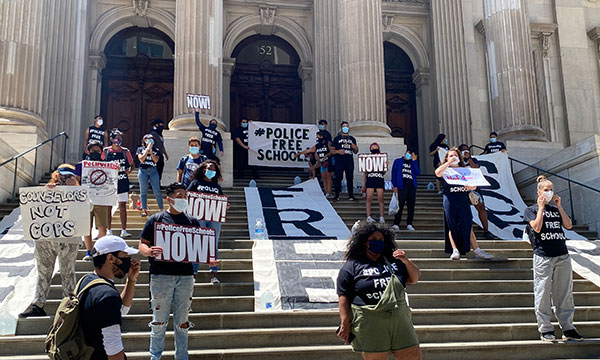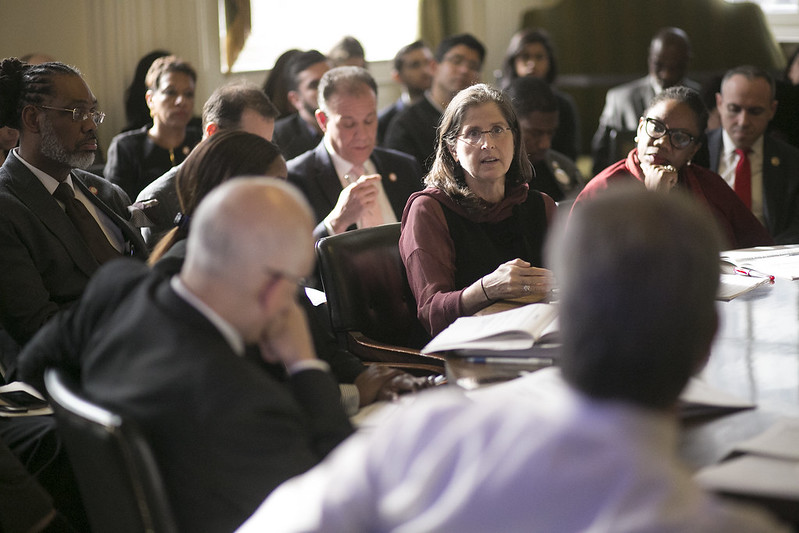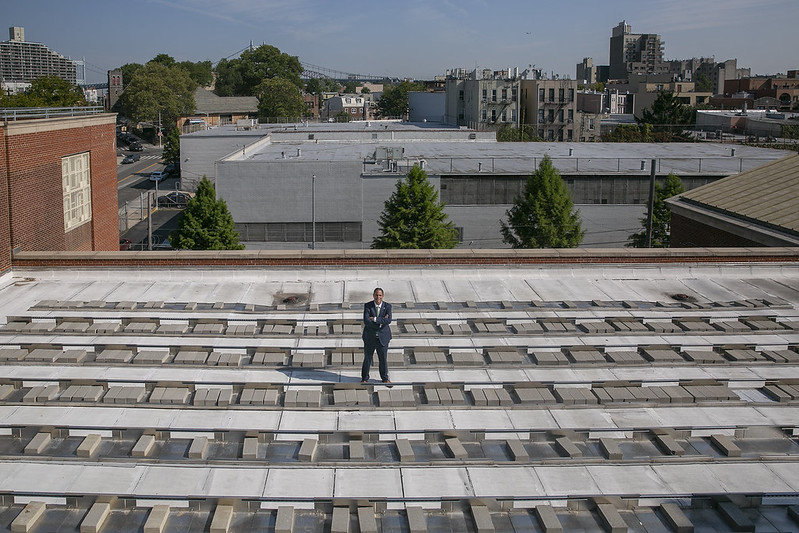Make My School and All Others Police-Free

Students rally for police-free schools (photo: Urban Youth Collaborative)
Every morning, I walk through a metal detector to start my day. I’m one of thousands of students who attend heavily policed schools, where there are more school safety agents than nurses, guidance counselors, and therapists combined. Students of color like me deserve to feel safe and supported, not policed, in our classrooms — but a new proposal to simply transfer school safety agents from the NYPD to the Department of Education is no solution at all. For us students, the answer is clear: we need completely police-free schools.
Right now, even in a terrifying economic crisis, New York City spends more than $450,000,000 a year on over 5,100 school safety agents and policing equipment. In contrast, the average school in New York employs just one guidance counselor for every 357 students, and many of our schools are deeply underfunded in every other way. This divide — funding the police and underfunding everything else — is especially true in majority Black and brown schools like mine. But just one neighborhood away, my friend goes to a majority-white school without a single metal detector. The message we hear from the city is loud and clear: policing students of color is more important than educating us.
The ironic truth is that instead of creating a safe learning environment, the constant presence of cops makes us feel like criminals — and actually escalates conflicts between students and between students and adults. I’ve seen too many incidents that could have been resolved with counseling, but instead became violent because students panicked when the cops came in with handcuffs and batons. The data shows that policing does not reduce bullying or fighting, and instead criminalizes behavior that would just merit a visit to the principal's office in a better-off school. My worst experiences with cops in school are much less traumatic than those of many of my friends, but even day-to-day interactions — like getting pulled aside and examined, hands on the wall, when I forget my phone in my pocket while walking through a metal detector — are dehumanizing.
I’m glad to see that the public — and even the City Council — is beginning to see how dangerous this reality is. But let me be clear: we cannot settle for the sham proposal of transferring school safety agents from the NYPD to the DOE. A cop is still a cop — no matter who they’re getting their salary from.
Instead, New York City needs to invest in learning environments that will prevent the roots of violence. That means significantly increasing the ratio of guidance counselors to students. It means making sure that we have trained psychologists available to talk to, from K through 12. And it means investing in restorative justice trainers to mitigate conflict, because we deserve to learn from our mistakes instead of being suspended or arrested for them.
When I imagine a school that feels safe, I imagine walking into school and going straight to class — no metal detector in sight, no cop cars stationed outside, no school safety agents standing on the edge of the cafeteria, waiting to pounce. I know it's possible, because thousands of students in wealthier and whiter neighborhoods live that reality every day. Mayor Bill de Blasio and Speaker Corey Johnson — we demand that you give us the police-free schools that we deserve.
***
Akeria Adams is 16 year olds, attends Academy of Medical Technology in Queens, and is part of The Urban Youth Collaborative.
***
Have an op-ed idea or submission for Gotham Gazette? Email This email address is being protected from spambots. You need JavaScript enabled to view it.
New York City Can Rebuild Through This Budget Crisis – Here’s How

City Council Member Helen Rosenthal, the author (photo: William Alatriste/City Council)
By the end of the month, just a few days from now, New York City will have to pass a balanced budget. With additional drops in revenue, looming state cuts to education and health-care funding, and the growing unlikelihood of federal support for states and localities, piecing together a budget that does not cut critical programs and services will be almost impossible.
What does this mean for our future? How can we keep residents from giving up on New York City? How can we bring our local economy back?
As I’ve noted many times, there is no one silver bullet. To address its $10+ billion revenue shortfall, the city must assemble a package of solutions including productivity savings, cuts to services, new revenue opportunities, use of reserves, and borrowing. We need to be strategic and smart about how we close the gaps, while not further impacting our neighbors who have been most affected by the crisis.
The City Council has already identified roughly $3 billion in cuts and savings. This includes eliminating NYPD training academy classes and other cuts to the police department’s now $6 billion budget, trimming the Department of Education’s bloated central office, along with program and contract cost re-estimates across all city agencies. The city also has roughly $4 billion in reserves that can be used in the current crisis.
One thing is painfully clear -- additional cuts beyond those identified above will do more harm than good. Large-scale cuts would force thousands of city employees and other essential workers paid through city contracts to lose their jobs and health-care benefits. Many of these are union jobs. The people we need to keep our city functioning would be forced onto unemployment, impacting every aspect of society, from local businesses to our tax base.
An all-out austerity budget is also untenable because we are in the midst of a massive public health crisis. To date, the city has spent over $3 billion to keep New Yorkers safe -- from ventilators and masks to feeding over 1 million people every day to remote learning services for our children. And as we look toward opening schools in September, we must spend more money to keep our schools free of the coronavirus. One positive has been that some of these outlays have been subsidized through federal relief money targeted to covid-related expenses.
But given the budget hole and the damage more agency cuts would do, we must talk about bringing in more revenue. I continue to fight for creative solutions, such as the reinstatement of the Securities Transfer Tax, which could generate billions for New York City and State.
Borrowing - likely $2 billion this year - also has to be part of the conversation. The concept is a third rail for some legislators because it harkens back to a time when the city borrowed money under very different circumstances. It’s important to note that the fiscal crisis of the 1970s was caused by several factors unique to that period -- decades of population loss; hemorrhaging of local employers (especially industrial businesses) that helped impoverish the population and intensify the need for social spending; and poor management of the city’s finances.
But here is where times have changed. Prior to this pandemic, the rating agencies were confident in New York City’s ability to maintain a balanced budget. In February 2020, the city was awarded an Aa1 rating by Moody’s -- the highest in recent history. By mid-March, however, the coronavirus pandemic was crushing local economies everywhere. Without jobs, people can’t pay rent or taxes. Without revenue, the city can’t supply basic services, and meet the growing demand for food, health care, and social services.
Borrowing comes with real costs of course. The circumstances and depth of the crisis in the 1970s forced the city to relinquish a certain amount of control over its budget in exchange for financial relief. Today’s crisis requires different guardrails and strong oversight, but there is no need for the Financial Control Board to be re-activated wholesale with a state takeover of the city’s budget.
And there are other risks. Every $1 billion borrowed will cost New York City $25 million annually, assuming we use the full loan term to pay back what is owed. The city budget will take on this debt. We have to weigh these costs against what is needed to get us back on our feet.
Finally, as counter-intuitive as it sounds, additional, targeted city spending makes sense at this moment. A recent analysis by the City Comptroller found that over 900,000 fewer New Yorkers were working in May than in February. Communities of color and young people under age 24 have been particularly hard hit.
Such job losses weaken our economy further. We should continue to invest in our residents and our recovery through robust job training programs (including the Summer Youth Employment Program), and limiting cuts to social service programs. Beyond this, an additional $2-3 billion of borrowing could be split between the purchase of homes heading to foreclosure (before predatory equity buyers swoop in), plus some targeted infrastructure and housing construction. These investments will save taxpayer dollars in the long-term.
Even in a devastating crisis we have choices. Let’s not be afraid to plan for a more vibrant, caring, sustainable city while we adjust to a new fiscal landscape.
***
City Council Member Helen Rosenthal represents parts of Manhattan. On Twitter @HelenRosenthal.
***
Have an op-ed idea or submission for Gotham Gazette? Email This email address is being protected from spambots. You need JavaScript enabled to view it.
With Green Participatory Budgeting, Racial Justice and Climate Justice Go Hand in Hand

Solar panels in Queens (photo: William Alatriste/City Council)
The Black Lives Matter movement that has swept the country shows that New Yorkers demand not only equal treatment by law enforcement and an end to police brutality, but also greater government accountability and responsiveness to the needs of Black residents and other New Yorkers of color. Even before the protests began last month, the disproportionate impact of COVID-19 on Black and brown New Yorkers made clear that the pre-coronavirus world was unsustainable. Structural racism has magnified the crisis brought by the virus, especially in New York City. As we look to a post-covid future, we have to imagine a more equal society.
The pandemic and protests also highlight the urgency of fighting climate change — even as we stay focused on containing the epidemic, rebooting the economy, and responding to protesters’ demands. The United States has largely been unprepared for the pandemic, despite knowing for years that such a crisis could occur. Similarly, officials have known about the potential threat posed by climate change for decades. And the devastation caused by the virus might pale in comparison to the climate crisis, with more frequent and intense heat waves, more powerful hurricanes and flooding, food insecurity, and water shortages.
Climate change will also exacerbate the inequality that COVID-19 and police brutality have exposed: New Yorkers who struggle to make ends meet may be unable to bear the financial burden of rebuilding or moving if their homes are threatened by severe flooding, and the health dangers of heat waves and pollution disproportionately threaten New Yorkers of color. The City is already working to mitigate these risks. As New York City Chief Climate Policy Advisor Daniel A. Zarrilli wrote in April, “we can choose to emerge stronger and more resilient from this crisis with a green recovery that prioritizes clean energy infrastructure, job creation, and environmental justice.”
Green participatory budgeting, with which New York City can both tackle climate change and create a more equal, democratic society, should be part of this green recovery.
Participatory budgeting was first implemented 30 years ago in Porto Alegre, Brazil; the process allows citizens to propose and vote on local investment projects using a portion of the city’s budget. New York City’s participatory budgeting program, now carried out in dozens of City Council districts, launched in 2011. Studies from the City University of New York have shown that participatory budgets succeed in giving marginalized residents more power over their communities and are “more inclusive and attractive than local elections in terms of race and class,” which can help to reduce inequality.
By launching “green” participatory budgets — allocating money specifically towards projects focused on reducing greenhouse gas emissions and making neighborhoods more resilient to the effects of climate change — New York City can channel citizens’ enthusiasm to fight climate change into productive action and, at the same time, enjoy the social and democratic benefits of participatory initiatives.
Lisbon, which won the 2020 European Green Capital Award, may have been the first city to implement a green participatory budget last year, when it allocated 5 million euros to the initiative. Brussels’ city climate plan also includes a green participatory budget.
In May, Gotham Gazette reported that the expanded, citywide participatory budgeting program envisioned by the new Civic Engagement Commission is unlikely to be funded in light of the city’s fiscal crisis. However, the scale of the protests over the past two weeks shows that the city must be creative and flexible in reallocating resources. Funding as much of the Civic Engagement Commission’s $500 million proposal as possible, and allocating a portion of that budget to a green participatory budget, would represent a strong investment in New York communities most affected by COVID-19 and racism — which are often the same communities most vulnerable to the effects of climate change.
Right now, as New York City focuses on the multifaceted challenge that confronts it, it’s hard to imagine rolling out a new initiative like a green participatory budget. But this crisis has proven that robust local democracy is vital to provide solutions for our most pressing problems — and that New York residents are yearning for a more inclusive, just city. As we reconstruct our society in a post-covid world and strive to affirm that Black lives matter, let’s do everything we can to tackle the existential threat of climate change, and empower citizens to take matters into their own hands.
***
Nikhil Kumar is a recent graduate of the Harvard Kennedy School. He has worked on participatory democracy and municipal climate policy in Strasbourg and Helsinki.
***
Have an op-ed idea or submission for Gotham Gazette? Email This email address is being protected from spambots. You need JavaScript enabled to view it.




